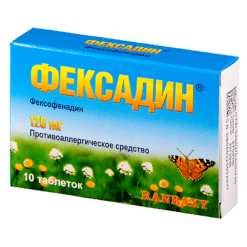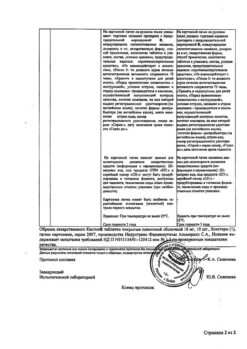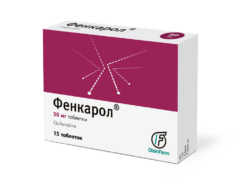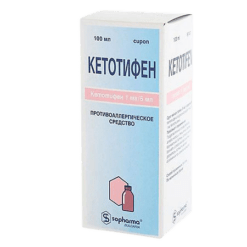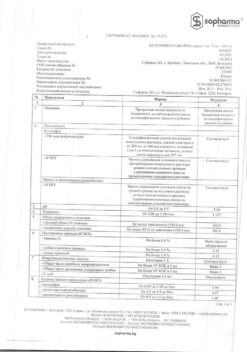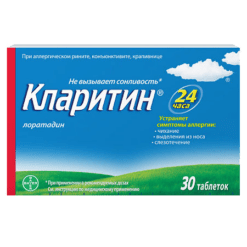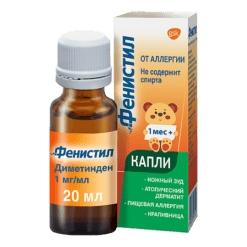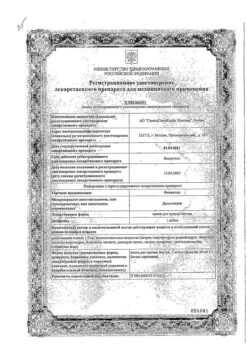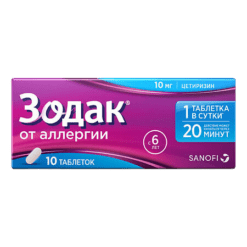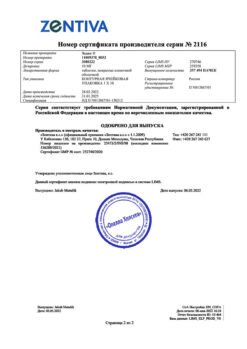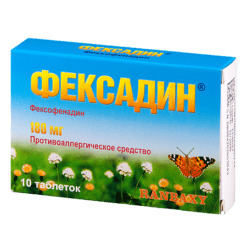No products in the cart.
Description
Pharmacotherapeutic group: anti-allergic agent – H1-histamine receptor blocker.
The ATC code: R06AE09
Pharmacological properties
Pharmacodynamics
Levocetirizine (R)-enantiomer of cetirizine is an inhibitor of peripheral H1-histamine receptors.
Levocetirizine has a pronounced antihistamine and anti-allergic effect. It affects histamine-dependent phase of allergic reaction, decreases migration of eosinophils, decreases vascular permeability and limits release of inflammatory mediators.
Levocetirizine prevents development and facilitates allergic reactions, has antipruritic and antiexudative action. It has practically no effect on cholinergic and serotonin receptors and has no sedative effect in therapeutic doses.
Pharmacokinetics
The pharmacokinetics of levocetirizine changes linearly.
Intake
After oral administration, the drug is quickly and completely adsorbed from the gastrointestinal tract. Food intake does not affect the completeness of absorption, although the speed of absorption is reduced. In adults, after a single therapeutic dose (5 mg) the maximum concentration (Cmax) in plasma is 270 ng/ml, reached after 0.9 hours, after reuptake in 5 mg dose – 308 ng/ml. The equilibrium plasma concentration (Css) is reached after 2 days.
Distribution
Levocetirizine is 90% bound to plasma proteins. The volume of distribution (Vd) is 0.4 l/kg. Bioavailability reaches 100%.
Metabolism
Less than 14% of the drug is metabolized in the body by N- and O-dealkylation (unlike other H1-histamine receptor antagonists, which are metabolized in the liver by the cytochrome system) to form a pharmacologically inactive metabolite. Due to limited metabolism and absence of metabolic inhibitory activity, interaction of levocetirizine on the metabolic level with other substances is unlikely. In adults the half-life (T1/2) is 7.9±1.9 hours, the total clearance is 0.63 ml/min/kg.
About 85.4% of the drug dose is excreted unchanged by kidneys via glomerular filtration and tubular secretion; about 12.9% – via intestine.
Particular pharmacokinetics in selected patients
Patients with impaired renal function
In patients with renal impairment (creatinine clearance (CK) < 40 ml/min) the drug clearance is decreased and T1/2 is prolonged. In patients on hemodialysis, total clearance is decreased by 80%, which requires a change in dosing regimen. Less than 10% of levocetirizine is eliminated during a standard 4-hour hemodialysis procedure.
Indications
Indications
Allerwei, film-coated tablets, 5 mg indicated in adults and children 6 years and older:
Active ingredient
Active ingredient
How to take, the dosage
How to take, the dosage
Interaction
Interaction
Special Instructions
Special Instructions
Synopsis
Synopsis
Contraindications
Contraindications
Side effects
Side effects
Clinical Studies
The following side effects occurred during clinical trials in men and women 12-71 years of age with an incidence of 1% or more (often ⥠1/100, < 1/10): Headache, drowsiness, dry mouth, and fatigue; asthenia and abdominal pain occurred infrequently (⥠1/1000, < 1/100).
Headache and somnolence occurred with an incidence of 1% or more (often ⥠1/100, < 1/10) in children aged 6 years to 12 years during clinical trials.
Post-registration studies:
General disorders:
If any of the side effects listed in the instructions worsen, or if you notice any other side effects not listed in the instructions, tell your doctor.
Overdose
Overdose
Pregnancy use
Pregnancy use
Similarities
Similarities
Additional information
| Weight | 0.010 kg |
|---|---|
| Shelf life | 2 years. |
| Conditions of storage | Store at the temperature not more than 25 °C. Keep out of reach of children! |
| Manufacturer | Dr. Reddy's, India |
| Medication form | enteric soluble tablets |
| Brand | Dr. Reddy's |
Related products
Buy Allerway, 5 mg 10 pcs. with delivery to USA, UK, Europe and over 120 other countries.


